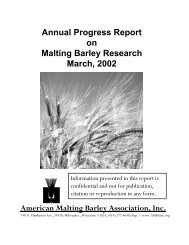Annual Progress Report on Malting Barley Research March, 2007
Annual Progress Report on Malting Barley Research March, 2007
Annual Progress Report on Malting Barley Research March, 2007
You also want an ePaper? Increase the reach of your titles
YUMPU automatically turns print PDFs into web optimized ePapers that Google loves.
2. Other <strong>Research</strong><br />
(A) Predicting Seed Storage Viability with Accelerated Aging: Widespread<br />
occurrence of pre-harvest sprouting in 2002 raised c<strong>on</strong>cern over the storage viability of<br />
sprouted grain. We found that while severely sprouted samples rapidly lost viability in<br />
storage, comm<strong>on</strong> measures of sprouting were not good overall predictors (r≤0.50) of<br />
germinati<strong>on</strong> following storage for 4 and 7 m<strong>on</strong>ths (Schwarz et al. J. ASBC 62(4):147,<br />
2004). Germinati<strong>on</strong> following accelerated seed aging was found to be a more reliable<br />
predictor (r=0.73) of germinati<strong>on</strong> following 7 m<strong>on</strong>ths of storage. Accelerated aging is<br />
performed by heating seed at 41 o C for 48 hr at 80% RH prior to germinati<strong>on</strong> testing.<br />
This treatment resulted in a 0 to 50% reducti<strong>on</strong> in the observed germinative energy.<br />
The objective of this study is to evaluate the utility accelerated seed aging to predict the<br />
l<strong>on</strong>g term storage viability of barley. The study was initiated with the 2004 crop, and<br />
sample collecti<strong>on</strong> will be c<strong>on</strong>tinued for through 2006. Where possible, samples will be<br />
selected to include some sprouting. Storage is at room temperature (24 o C), 7 o C, and<br />
under outdoor ambient c<strong>on</strong>diti<strong>on</strong>s. Germinative will be determined 3 times each year,<br />
and for a total of 3 years storage. Accelerated aging is performed, as described above,<br />
following harvest. Data for the 2004 -2006 samples is shown in Table III.<br />
Table III<br />
Germinati<strong>on</strong> and Sprouting Parameters of the 2004 - 2006<strong>Barley</strong> Samples<br />
Selected for Study of Storage Viability (data is 4 m<strong>on</strong>ths post-harvest)<br />
Germinative<br />
Energy<br />
(4 ml, %)<br />
2004 2005<br />
2006 2004<br />
Accelerated Aging<br />
Germinative Energy<br />
(%)<br />
2005 2006 2004<br />
Water Sensitivity<br />
(4-8 ml, %)<br />
2005 2006 2004<br />
RVA<br />
Stirring Number<br />
2005 2006<br />
N 15 15 15 15 15 15 15 15 15 15 15 15<br />
Mean 92 95 98 72 86 93 33 24 7 101 127 135<br />
Minimum 85 77 84 8 77 40 9 4 0 5 65 4<br />
Maximum 100 100 100 93 100 100 75 48 40 216 191 242<br />
(B) <strong>Barley</strong> CAP Project (Dr Yin Li). We are screening 960 breeder’s lines for betaglucanase<br />
activity as part of the <strong>Barley</strong> CAP Project (<strong>Barley</strong> Coordinated Agricultural<br />
Project). Lines will be screened at low and elevated temperatures to detect possible<br />
differences in thermostability. A subset of the 960 lines will also be analyzed for<br />
lipoxygenase activity.<br />
The barley Coordinated Agricultural Project (CAP) is a community effort of 30 scientists<br />
from 19 instituti<strong>on</strong>s (http://barleycap.coafes.umn.edu/ ). The University of Minnesota is<br />
87
















